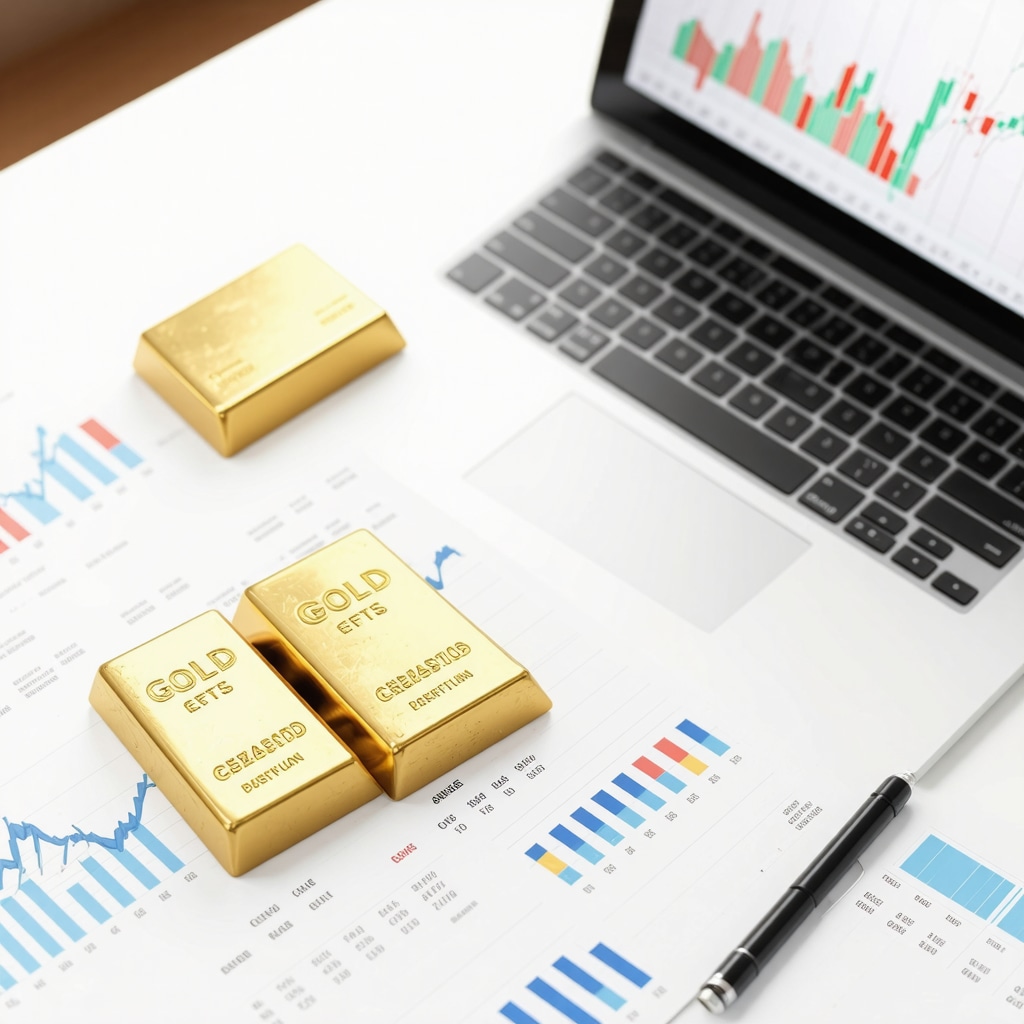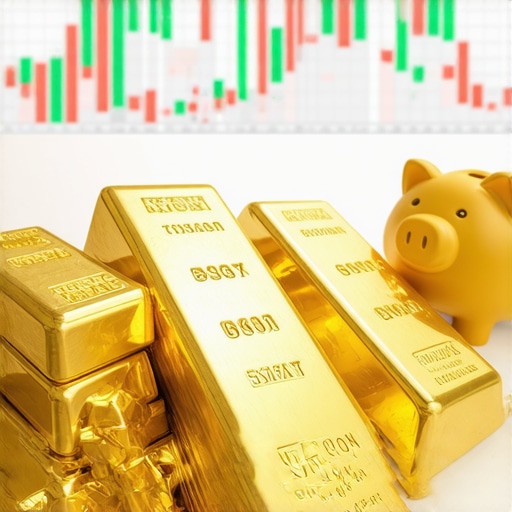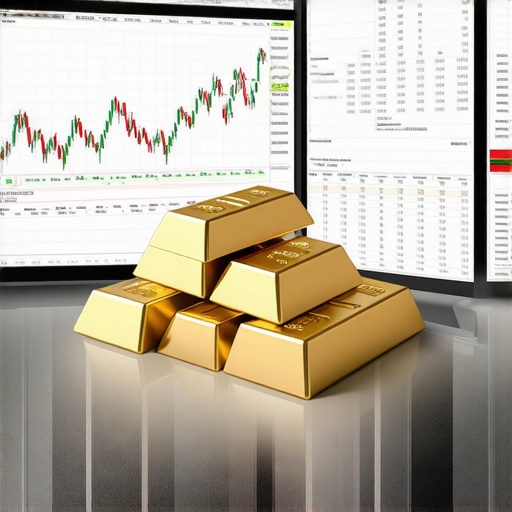Why I Decided to Include Gold ETFs Alongside Stocks in My Portfolio
When I first started investing, I was all about stocks—tech companies, dividend payers, you name it. But after experiencing some market volatility firsthand, I realized I needed a better way to balance risk and preserve capital. That’s when I turned my attention to gold ETFs. Unlike physical gold, gold ETFs offered me liquidity and ease of trading, but with the price exposure to gold’s safe-haven qualities. This personal shift helped me create a more balanced investment mix that could weather uncertainty better.
My Journey to Balancing Gold ETFs and Stocks: What Worked for Me
Building a balanced portfolio wasn’t an overnight process. I started by allocating a modest 10-15% of my portfolio to gold ETFs, combining it with a diversified basket of stocks from different sectors. This allocation gave me the downside protection I sought without sacrificing growth potential. Over time, I adjusted my exposure, increasing gold ETFs slightly during periods of economic uncertainty. I also explored gold mining stocks, which added an interesting dynamic but with more volatility than ETFs.
How Do Gold ETFs and Stocks Complement Each Other in a Portfolio?
From my experience, gold ETFs tend to move independently of stocks, often rising when stock markets fall. This inverse correlation provides a cushion during market dips. Stocks offer growth, dividends, and capital appreciation, while gold ETFs act as a hedge against inflation and currency fluctuations. This synergy is why many financial experts recommend combining both. For example, the World Gold Council highlights that gold is a proven diversifier that can improve risk-adjusted returns (source).
Practical Tips I Learned for Choosing the Right Gold ETFs
Not all gold ETFs are created equal. I prefer ones with low expense ratios and good liquidity. Some track physical gold prices closely, while others include gold mining companies. For a beginner, sticking to ETFs that track spot gold is simpler and less risky. I also recommend doing your homework on the fund provider’s reputation and the ETF’s structure. If you want to dive deeper, check out this ultimate guide to gold ETFs for beginners that helped me clarify many aspects of these investments.
Why Diversification Still Matters Even with Gold in Your Portfolio
Adding gold ETFs to my stock portfolio definitely helped, but I learned that diversification is about more than just two asset types. I spread my stock investments across sectors and geographies and keep an eye on gold supply and demand trends to anticipate price movements. Staying informed through resources like gold supply and demand insights has sharpened my investment decisions.
If you’ve experimented with balancing gold ETFs and stocks or are considering it, I’d love to hear your experiences or questions in the comments below. Sharing insights always makes this journey richer!
Understanding the Nuances of Gold ETF Exposure Beyond Basic Allocation
While starting with a 10-15% allocation to gold ETFs is a solid approach, refining that allocation based on macroeconomic signals and personal risk tolerance can substantially improve outcomes. For instance, during periods of rising inflation expectations or geopolitical tensions, increasing your gold ETF exposure can act as a more effective hedge. Conversely, in strong bull markets for equities, you might reduce gold holdings slightly to capitalize on stock gains. This dynamic balancing requires diligent monitoring of economic indicators and market sentiment.
Incorporating Sector-Specific Insights to Optimize Your Gold and Stock Mix
Gold ETFs provide diversification primarily due to their non-correlation with stock markets, but not all stocks react uniformly to market stress. Defensive sectors like utilities and consumer staples often behave differently than cyclical sectors such as technology or industrials. By selectively increasing exposure to these defensive sectors alongside gold ETFs, you can further smooth volatility and enhance portfolio resilience. This layered diversification strategy leverages different market dynamics effectively.
What Are the Risks and Rewards of Adding Gold Mining Stocks Compared to Gold ETFs?
Gold mining stocks represent an intriguing hybrid investment: they provide leverage to gold price movements but come with additional company-specific risks such as operational challenges and management effectiveness. Unlike gold ETFs, which track the metal price directly, mining stocks can experience heightened volatility. However, they also offer growth potential through exploration success or cost reductions. Balancing between gold ETFs and mining stocks depends on your appetite for risk and investment horizon. For those interested in exploring this further, this detailed comparison offers expert insights.
Leveraging Gold Price Forecasts and Economic Indicators for Tactical Adjustments
Monitoring gold price forecasts and key economic drivers allows investors to time portfolio adjustments more strategically. Factors like central bank gold purchases, currency movements, and inflation data often signal shifts in gold demand and price trajectories. For example, the latest 2025 gold price forecast highlights how geopolitical uncertainties and monetary policies will likely influence market dynamics. Incorporating such forecasts enables proactive balancing between gold ETFs and stocks rather than reactive rebalancing.
Practical Storage and Security Considerations for Physical Gold Investors
Though ETFs offer convenience, some investors prefer holding physical gold for tangible security and privacy. This introduces considerations around safe storage, insurance, and liquidity. Choosing reputable vaulting services or secure home storage solutions is critical. I found that understanding these logistics reduces anxiety and ensures that physical gold truly fulfills its role as a portfolio safeguard. For comprehensive tips, visit expert guidance on safe physical gold storage.
By deepening your understanding and continuously adapting your approach, balancing gold ETFs and stocks can evolve from a simple allocation task into a sophisticated, resilient investment strategy. If you have experiences or questions about these advanced tactics, please share your thoughts in the comments below to enrich our community’s knowledge.
Reflecting on the Emotional Dynamics of Balancing Gold ETFs and Stocks
One subtle aspect I hadn’t anticipated when I first mixed gold ETFs and stocks was the emotional comfort gold provided during turbulent times. Watching stock prices swing wildly can trigger anxiety, but seeing gold ETFs hold steady or even gain in those moments felt like a psychological anchor. This helped me avoid panic selling and stick to my investment plan. It’s a reminder that beyond numbers, the psychological impact of diversification is real and often underappreciated.
How Has My Approach to Gold ETF Allocation Evolved With Market Cycles?
Initially, I was rigid with my 10-15% gold ETF allocation, treating it like a fixed rule. Over time, I’ve learned to view it as a flexible tool responsive to market signals. For example, in late 2022, with rising inflation concerns and geopolitical tensions, I increased my gold ETF share closer to 20%. Conversely, when equities showed robust momentum, I trimmed back to capture growth. This adaptive approach aligns with insights from the 2025 gold price forecast, highlighting how macroeconomic factors should influence gold exposure.
Exploring the Complex Question: Can Gold ETFs Fully Replace Physical Gold in a Portfolio?
What Are the Trade-offs Between Gold ETFs and Physical Gold from a Long-Term Perspective?
From my personal experience and research, gold ETFs offer convenience, liquidity, and ease of trading, which are huge advantages, especially for those who want quick portfolio adjustments. However, physical gold carries an intrinsic value that can’t be affected by counterparty risks or digital system failures. It also offers privacy and a tangible sense of security, which some investors—including myself—value deeply. That said, owning physical gold requires careful thought about storage, insurance, and potential liquidity constraints (expert storage tips). For many, a combination of both—leveraging ETFs for agility and physical gold for security—is the sweet spot.
This balance depends heavily on individual goals and circumstances. I often revisit this question when considering portfolio resilience in extreme scenarios, such as financial system shocks where physical gold’s role as a non-digital asset shines.
Personal Lessons on Integrating Gold Mining Stocks Without Upending Portfolio Stability
Adding gold mining stocks brought a new flavor to my portfolio: potential for higher returns but with more volatility. I found that treating mining stocks as a satellite holding, capped at a smaller percentage, helped me capture growth opportunities without jeopardizing overall stability. It also introduced me to company-specific analysis—evaluating management quality, cost structures, and geopolitical risks affecting mines.
For those interested in this nuanced balance, this detailed comparison sheds light on when mining stocks might complement or complicate your strategy.
Why Staying Curious and Engaged Continues to Shape My Investment Decisions
The gold and stock balancing act is far from static. Each market cycle brings new lessons and opportunities. Staying informed through quality resources and engaging with community insights has been invaluable. I encourage you to explore advanced guides like the ultimate guide to balancing gold supply and demand to deepen your understanding.
If you’ve found unique ways to optimize your gold and stock mix or faced challenges navigating these investments, I’d love to hear your stories. Sharing can spark ideas and help us all grow as investors.
Fine-Tuning Portfolio Dynamics: Beyond Static Gold ETF Allocations
One of the most profound realizations I’ve had is that a portfolio’s allocation to gold ETFs shouldn’t be static but rather a fluid component responsive to shifting economic landscapes. While the conventional wisdom often prescribes a fixed 10-15% gold allocation, my experience suggests that tuning this percentage in response to macroeconomic shifts can significantly enhance portfolio resilience. For example, during the heightened inflationary pressures observed in early 2023, I increased my gold ETF weighting, anticipating a potential erosion of purchasing power in equities. Conversely, in periods marked by strong equity rallies fueled by technological breakthroughs or fiscal stimulus, I have prudently scaled back my gold exposure to capture capital appreciation potential.
This adaptive strategy aligns with insights from the 2025 gold price forecast, which emphasizes the importance of monitoring geopolitical tensions and monetary policy shifts as critical signals for adjusting gold holdings. The key is to avoid a rigid mindset and instead cultivate an agile investment approach that leverages gold ETFs not merely as a static hedge but as a tactical instrument within a broader asset allocation framework.
Harnessing Sectoral Nuances: Merging Gold ETFs with Defensive Stock Selections
Delving deeper into portfolio construction, I’ve found that pairing gold ETFs with carefully selected stock sectors amplifies diversification benefits. Defensive sectors such as utilities, healthcare, and consumer staples often exhibit lower volatility and more stable cash flows during economic downturns, which complements gold’s safe-haven attributes remarkably well. By strategically overweighting these sectors alongside gold ETFs, I have achieved smoother portfolio volatility and enhanced downside protection without significantly compromising growth potential.
This layered diversification acknowledges that not all equities react uniformly to market stress. For instance, cyclical sectors like industrials and discretionary consumer goods tend to be more sensitive to economic cycles, thus warranting a calibrated exposure when balancing with gold. This nuanced approach, informed by sector-specific insights, has been instrumental in refining my portfolio’s risk-return profile.
How Can Investors Integrate Gold ETFs with Alternative Assets for Enhanced Resilience?
Beyond the traditional stock and gold ETF mix, I’ve increasingly explored incorporating alternative assets such as real estate investment trusts (REITs), commodities other than gold, and fixed income instruments into my portfolio. The rationale is to broaden diversification vectors and mitigate correlated risks, especially in volatile markets. For instance, REITs often provide income stability and inflation hedging characteristics complementary to gold’s role.
Integrating these assets demands a sophisticated understanding of their interaction effects and liquidity profiles. My approach involves periodic reviews of asset correlations and rebalancing thresholds to maintain an optimal blend that aligns with my evolving risk tolerance and market outlook. For readers interested in a comprehensive framework for diversification, the beginners guide to creating a diversified gold investment portfolio offers valuable foundational insights.
Psychological Fortitude: The Hidden Value of Gold ETFs in Investor Behavior
Beyond quantitative metrics, I’ve come to appreciate the qualitative, psychological dimension of holding gold ETFs. During market turbulence, the presence of gold in my portfolio instills a sense of confidence and emotional steadiness, acting as a psychological buffer against panic-induced decisions. This emotional anchoring effect is subtle yet powerful, helping me adhere to my investment discipline and avoid costly mistakes like impulsive sell-offs.
Recognizing this, I now consciously communicate to fellow investors that diversification is as much about managing emotions as it is about balancing numbers. The intersection of behavioral finance and asset allocation strategies remains a fertile ground for enhancing investment outcomes.
If you’ve experimented with advanced portfolio balancing techniques or grappled with the emotional challenges of market volatility, I invite you to share your experiences and perspectives in the comments below. Engaging in this dialogue enriches our collective understanding and empowers us all to make more informed, resilient decisions.
Things I Wish I Knew Earlier (or You Might Find Surprising)
Gold’s Emotional Safety Net Matters More Than You Think
When I first added gold ETFs alongside stocks, I underestimated how much peace of mind they’d bring me during market turmoil. It’s not just about numbers or diversification; it’s that feeling of calm when equities are volatile but gold holds its ground. This psychological comfort helped me avoid rash decisions and stay the course.
Flexibility Beats Fixed Rules in Gold Allocation
I used to rigidly stick to a 10-15% gold ETF allocation, thinking it was a magic formula. Over time, adapting my exposure based on inflation trends, geopolitical tensions, and stock market momentum led to better outcomes. This dynamic approach allowed me to harness gold’s protective qualities when needed and lean into stocks when the market was strong.
Not All Gold ETFs Are Created Equal
Early on, I didn’t realize how important it was to choose ETFs with low fees, strong liquidity, and transparent holdings. Some ETFs track physical gold directly, others include mining companies or derivatives — and that can impact risk and returns. Doing research upfront saved me from surprises.
Sector Selection Amplifies Diversification Benefits
Pairing gold ETFs with defensive stock sectors like utilities and consumer staples smoothed out portfolio swings more effectively than just combining gold with broad equities. Recognizing that not all stocks behave the same during downturns changed how I built balanced portfolios.
Physical Gold Still Has a Place, Depending on Your Goals
While gold ETFs offer convenience and liquidity, owning physical gold provides a tangible security layer that digital assets can’t replace. I learned that a hybrid approach—holding both physical gold and ETFs—works best to balance agility with long-term safety.
Resources I’ve Come to Trust Over Time
World Gold Council: Their research on gold’s role in portfolio diversification helped me understand why gold often moves independently from stocks. They offer clear, data-backed insights perfect for investors wanting credibility.
Buying Gold Now’s Ultimate Guide to Gold ETFs for Beginners: This guide clarified the types of gold ETFs, fees, and how to pick the right ones. I recommend it to anyone starting out because it breaks down complex concepts into digestible advice.
Gold Price Forecast 2025 and Market Trends: Keeping up with economic drivers and geopolitical shifts through this forecast enabled me to fine-tune my gold exposure tactically rather than guessing based on emotion.
How to Store Physical Gold Safely – Expert Tips: For those considering physical gold, this resource was invaluable. It covers storage options, insurance, and security considerations that I wish I had known earlier.
Comparing Gold ETFs and Gold Mining Stocks: This detailed comparison helped me weigh the additional risks and rewards of mining stocks versus ETFs, guiding my satellite holdings strategy.
Parting Thoughts from My Perspective
Balancing gold ETFs and stocks has been a journey of learning, adaptation, and sometimes surprising emotional insights. From my experience, the key isn’t just in hitting a fixed allocation but in nurturing a flexible, informed approach that responds to changing markets and personal risk tolerance. Gold ETFs provide a powerful hedge and psychological anchor, while stocks drive growth and income — together, they create a more resilient portfolio.
If you’re exploring this balancing act, I encourage you to stay curious, dive into trusted resources, and keep sharing your experiences. If this resonated with you, I’d love to hear your thoughts or questions. Feel free to drop your own stories in the comments below — our shared insights make this investment journey richer for everyone.











Reading through this detailed post really resonated with my own investment journey. I started with a heavy focus on stocks but quickly learned during the last market downturn how valuable gold can be as a hedge. The point about dynamically adjusting gold exposure based on macroeconomic signals is particularly insightful; I’ve found that being flexible rather than rigid with my asset allocation has paid off. Personally, I’ve had good luck with gold ETFs that track physical gold, mainly because of their liquidity and simplicity, but I’m curious about others’ experiences with gold mining stocks. Do you find they significantly outperform ETFs during bull phases or do the risks outweigh the potential gains?
Also, the psychological comfort of holding gold during volatile times cannot be overstated. It’s like having an emotional safety net. How do others balance this psychological aspect against the need for engagement with the market? I’d love to hear more about different strategies that help maintain discipline and calm during unpredictable market swings.